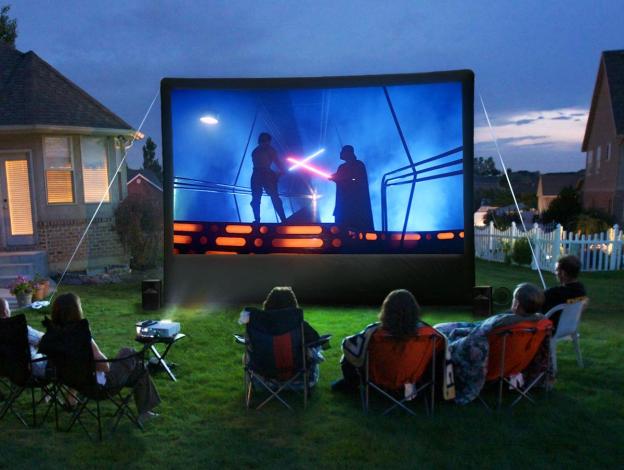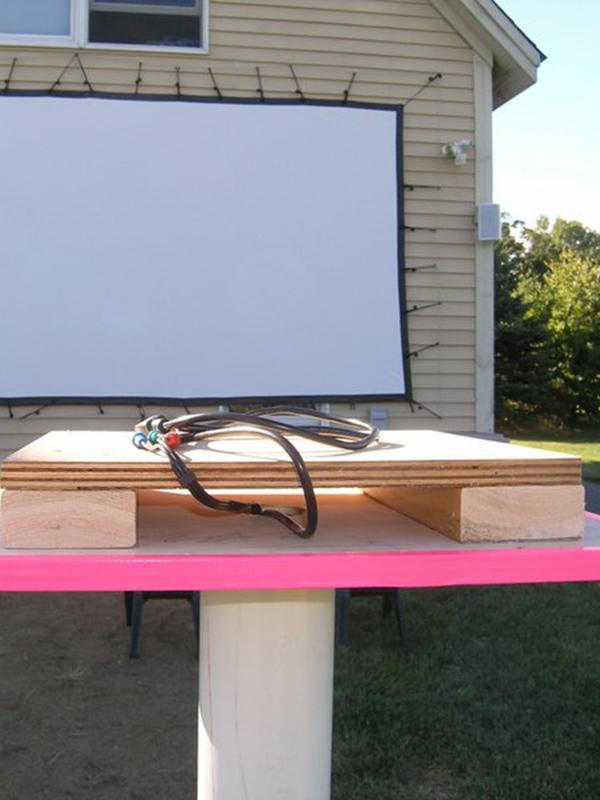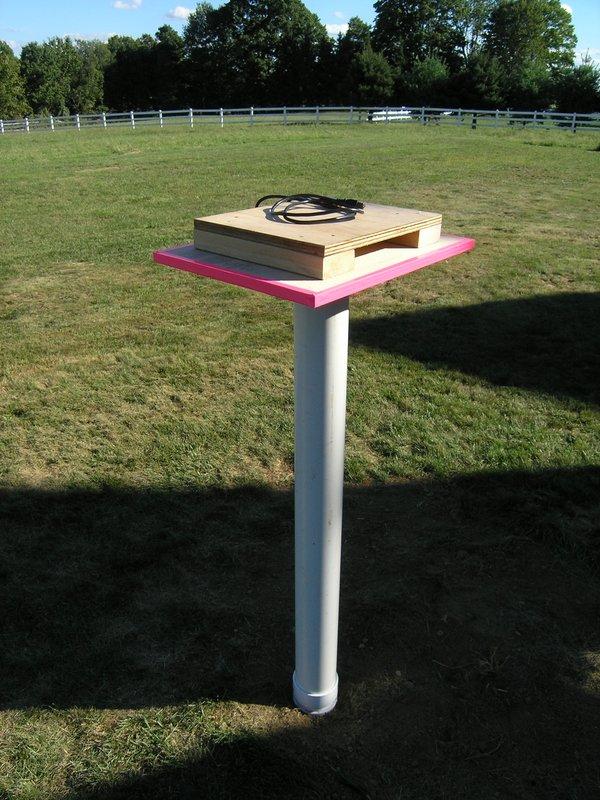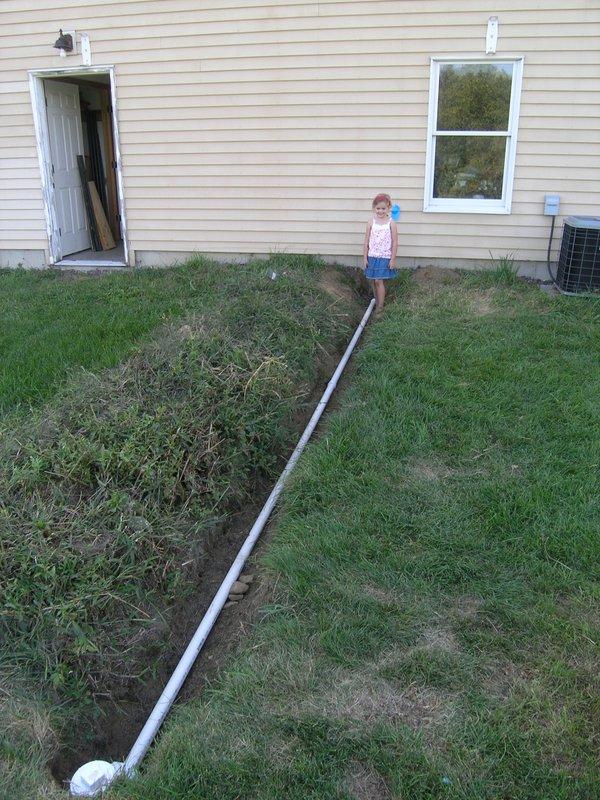
The great American love affair with the drive-in movie theater celebrates its 80th anniversary on June 6, 2013. Although less than 380 still exist across the United States, the drive-in survives on a smaller scale thanks to a growing number of enthusiasts who have taken the concept back to its place of origin: the driveway and backyard.
In 1932, about a year before he would open the first drive-in movie theater in Pennsauken, New Jersey, chemical magnate Richard M. Hollingshead Jr. experimented in his driveway by beaming images from a 1928 Kodak projector mounted to the roof of his car onto a screen mounted between trees in his backyard. Hollingshead Jr. was also the first to experiment with loudspeakers projecting sound from behind the screen, although the final concept would feature loudspeakers mounted to towers.
By the mid 1960s, more than 4,000 drive-in theaters existed across the United States and Canada, but that number was doomed to steadily decline over the next 20 years for a number of reasons. The land theaters occupied became increasingly valuable to developers, the adoption of daylight savings time robbed theater operators of one critical hour of projection time, and finally, color TVs and VHS made watching films at home more popular.
Just because you paid for that Blu-ray disc or download from Vudu, doesn’t give you the legal right to become the AMC down the street.
Recently, we’ve taken a look at some extreme indoor home theaters like the Kipnis Studio Standard and IMAX home theater concepts, but now we want to take the party outside in an effort to rekindle the spirit of the drive-in with an outdoor home theater. Can it be done without spending a fortune?
Not only is it possible, it is an amazing amount of fun as long as you follow some common sense rules. Let’s drive…er…dive in.
Don’t be that neighbor…
Depending on where you live, the concept of a driveway or backyard home theater may be a non-starter due to noise restrictions, safety regulations, or because you live in an apartment and it is unlikely that your landlord will permit a movie theater on the roof. Fair enough; who wants to be liable if a person or a piece of equipment goes flying? Really, as much as we think the idea of watching Star Wars 10 stories up under the stars sounds like a great plan, we also don’t think it’s worth the risk of someone getting hurt.
Bureaucracy aside, there are social norms to navigate. While those of us who live in suburbia like to think that what takes place within our property line is our business, the reality is that everyone has at least one neighbor who hates noise (at any hour) or the sound of adults and children having fun outdoors at night (misers!). As someone who lives on the edge of a college campus with the surrounding homes rented out to college students, I understand that concern very well. With a house filled with little children, we don’t appreciate it when they have loud, drunken parties until 4 am.
The smartest thing you can do is simply be a good neighbor and invite them. Even if they decline, it will let them know what you’re up to so you can avoid a visit from the local police, and if they show, you might even get some free beer or dessert out of it.
Are you licensed to thrill?
While it’s highly unlikely that an entertainment lawyer or someone from Interpol is going to drive by while you watch a movie in your driveway or backyard, the reality is that there are copyright laws that actually prohibit you from charging to watch a film on your property, or publicly advertising the showing. If you want to invite 20 of your closest friends over for a BBQ and to watch Django Unchained, that’s your business, but don’t make it public knowledge with a flyer. Just because you paid for that Blu-ray disc or download from Vudu, doesn’t give you the legal right to become the AMC down the street.
Keep it dark…
As much as we’d like to think it goes without saying, it’s important enough to reiterate: Watching movies outside is way more enjoyable when its dark.

Waging war with the the sun is an even worse proposition. Despite advances in projector and screen technology, it’s a losing battle unless you can afford something like the Stewart Oasis outdoor screen with Grayhawk or Firehawk material, and a projector with an extraordinary amount of light output. Just know this is an extremely expensive endeavor and it takes away from the D.I.Y. aspect of the project that makes it fun to begin with.
Getting started
We already know a 10-story rooftop is not a good place for an outdoor home theater. So what are some good options? For one, consider your driveway. Unless the mason responsible for your driveway was completely incompetent, its surface should be level enough to set up a portable screen, loudspeakers, chairs, and projector without much hassle. The driveway is also appealing since there’s probably a power receptacle inside your garage which will make set-up that much easier. Plus, should the weather turn nasty without much notice, you’ll be in a good position to move everything inside so you don’t have to watch your projector and audio equipment get destroyed (assuming your garage isn’t already packed, of course).

Aside from the location of the screen, the most important thing to consider when setting up an outdoor home theater is proximity to power. A heavy-duty extension cord (as long as 25 feet) and a power strip should be considered essential accessories. Aside from your projector, you will need to power your source (Blu-ray player or set-top box) and audio amplification. When possible, choose an outlet that is on a relatively clear circuit – you don’t want a sudden power outage in the middle of an exciting flick.
Permanent or temporary installation?
If you decide to go with a backyard location for your outdoor theater and you don’t mind assembling and disassembling the entire system every time you watch a film, using an extension cord and power strip is the best way to go for power needs. On the other hand, if your backyard theater is going to be a routine destination, a more permanent setup might not be a bad idea. The following is especially ideal for those who want to run their outdoor rig off an existing indoor home-theater setup.
Consider digging a trench from your home to the location where your projector is going to be installed. Line the trench with 4-inch PVC pipe and use enough of it to create a vertical base for a projector platform. Run both an extension cord and a single HDMI cable from inside your home through the pipe and have it exit through a hole in the platform. Make sure to fill it with putty so as to deter any unwanted guests who fancy a nice, dry tunnel into your house. (Note: If you own a swimming pool, remember to route all cables as far away as possible.)
Finally, if you decide to set up your outdoor HT away from the house, don’t forget to install some form of lighting. We think torch-mounted citronella candles are a great idea because they can be firmly secured into the ground and keep you and your guests safe and bug-free at the same time.
Go big and go home
Your choice of screen is as important as your choice of projector. Fortunately, the cost of a weather-proof outdoor screen is considerably less than that of a similarly-sized indoor screen.
While we understand the temptation to just hang a large sheet on a wall or between two trees, the reality is that a weather-proof screen such as the Elite Yard Master (starting at $250 for a 100-inch 16:9 screen with stand) or the FlexiWhite Bungee & Grommet projector screen from Carl’s Place (starting at $139 for a 120-inch 16:9 screen) makes a lot more sense.
Your choice of screen is as important as your choice of projector.
If money is no object, the electronically controlled and retractable Oasis from Stewart is our top pick. Since Stewart offers the Oasis with any of its screen materials, it is the best choice for those who insist on watching films during the day.
Inflatable screens have become popular lately, and if you don’t mind spending as much as $11,000 for a set-up that includes the screen, amplification, and loudspeakers, it may be an option to consider. There are considerably less expensive options available from Target, Wal-Mart, and other vendors, but we happen to like the Airscreen Airtight and AeroPro inflatable screens that are manufactured in Germany.

The smallest Airtight screen is 16-feet wide (16:9 aspect ratio) and requires a projector that can output more than 3,000 lumens. Expect to spend at least $4,500 for a complete package which includes all of the hardware, screen, blower, and repair kit.
A projector for all seasons?
Selecting an appropriate projector for use outdoors seems like a simple enough task, especially if you already own a LCD or DLP projector with a fairly high-lumen output rating, but do you really want to remove your existing projector from its mount and risk taking it outside? Also, aside from the risk of physical damage, are you up for recalibrating the projector for the new venue and screen material? If you plan to make outdoor shows a routine, a separate projector makes sense.
It’s better to prioritize brightness over resolution when a compromise is necessary.
If 3D projection strikes your fancy, stick with passive systems, which offer a brighter image and more affordable glasses. Expensive, battery-operated active 3D glasses are too valuable to risk having broken outside or carted off as a chew toy by the family pet.
Finally, before buying a projector, take into account its throw distance rating. This will affect where you can place your projector relative to your desired screen size. If you are at all constrained by where the projector can be placed, take that distance into account when making your projector and screen choices.
Stepping beyond drive-in audio quality
The final component of any driveway or backyard home theater is the sound; and you can have a lot of fun with this since there are so many options. For an outdoor system, we tend to recommend a 2.0 system. It’s more cost effective, easier to set up and generally more practical, since it requires the least amount of wiring.
If you’ve ever considered installing outdoor speakers that will be powered by your existing A/V receiver or multi-room audio set-up, this is the time to opt for a full-range pair that you can use for your backyard home theater. This particular loudspeaker segment has become extremely popular, with models offered by Paradigm, B&W, Definitive Technology, Polk Audio and Aperion audio (among many others) offering excellent sound quality and reliable protection from the elements.

All-weather loudspeakers from manufacturers such as JBL are also a good alternative in this scenario, if you’re looking for a resilient speaker that can project sound over a large area. If they can withstand the elements in outdoor facilities such as baseball stadiums and parks, they’ll do just fine in your backyard.
As tempting as it may be to run off and purchase a “home theater in a box” (HTiB) just for this set-up, our advice would be to save your money. These systems don’t have the projection or power necessary to stand up to the large picture they are being paired with. Better to pour your resources into a simple, two-channel system that can deliver a satisfying audio experience than waste it on surround speakers that won’t bring much to the party.
Fire up the grill and pass the popcorn
Regardless of your budget, there is a lot of fun to be had if you follow some of our tips and plan your driveway or backyard home theater carefully. Take a look at some of your older equipment and see if it meets your requirements for the project. The drive-in was never a high-end viewing experience, and we’re willing to bet that whatever you come up with will deliver a fun, social experience during those warm-weather months for your family and friends.
Turn your favorite family movie night into a fabulous themed event that the kids will never forget by taking a step back in time to a golden age when folks enjoyed the silver screen under the stars.
Photos courtesy of Greg Robinson/Ian White
Editors' Recommendations
- Best AV receivers 2024: top sound for your home theater
- How to build a backyard theater
- The best outdoor projector screens for 2023
- This is the perfect home theater setup for spooky Halloween movies!
- DTS Play-Fi wants to eliminate the speaker wires in your 5.1 home theater setup





